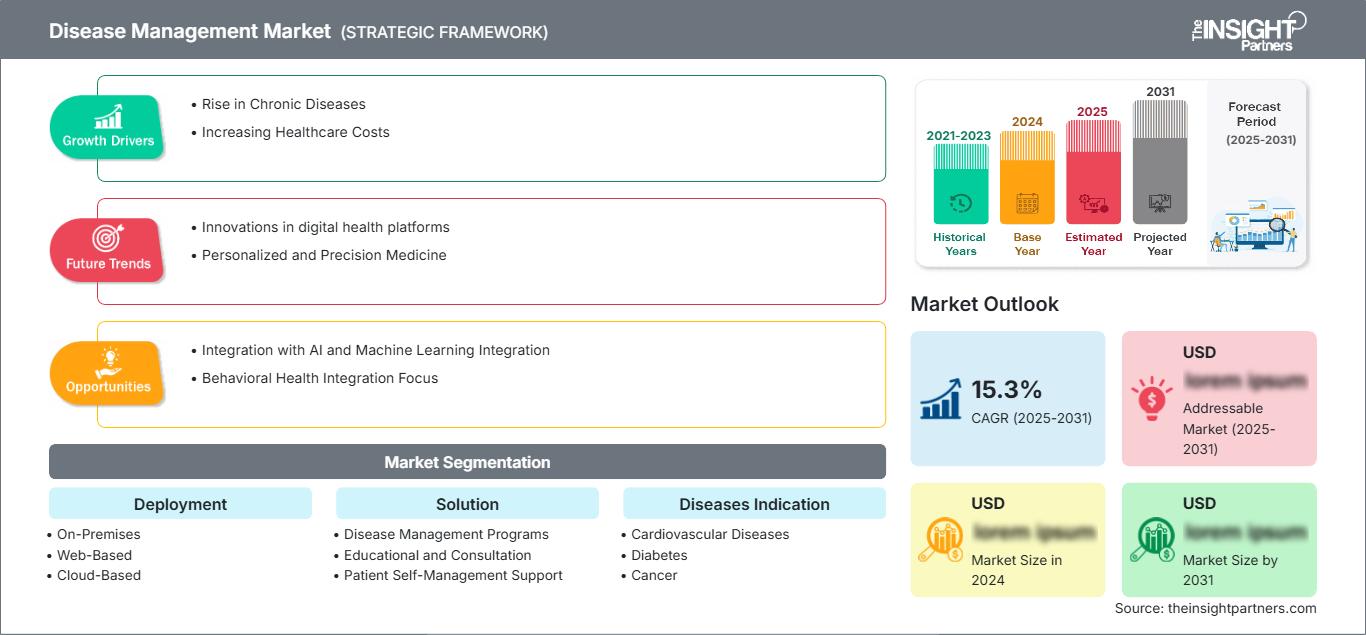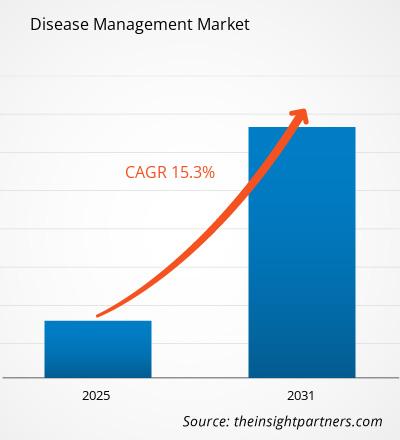Se espera que el tamaño del mercado de gestión de enfermedades alcance los 20.920 millones de dólares estadounidenses para 2031. Se anticipa que el mercado registre una CAGR del 12,7 % durante 2025-2031.
El informe está segmentado por implementación (local, web, en la nube); solución (programas de gestión de enfermedades [DMP], educación y consulta, apoyo a la autogestión del paciente, tecnologías de la información sanitaria [HIT], otros); indicación de enfermedades (enfermedades cardiovasculares, diabetes, cáncer, enfermedad pulmonar obstructiva crónica [EPOC], otros); usuarios finales (pagadores, proveedores, otros). El análisis global se desglosa a nivel regional y por países principales. El informe ofrece el valor en USD para el análisis y los segmentos mencionados.
Propósito del Informe
El informe "Mercado de Gestión de Enfermedades" de The Insight Partners busca describir el panorama actual y el crecimiento futuro, los principales factores impulsores, los desafíos y las oportunidades. Esto proporcionará información a diversas partes interesadas del negocio, como:
- Proveedores/fabricantes de tecnología: Para comprender la dinámica cambiante del mercado y conocer las oportunidades potenciales de crecimiento, lo que les permitirá tomar decisiones estratégicas informadas.
- Inversores: Realizar un análisis exhaustivo de tendencias respecto a la tasa de crecimiento del mercado, las proyecciones financieras del mercado y las oportunidades que existen en toda la cadena de valor.
- Órganos reguladores: Regular las políticas y las actividades policiales en el mercado con el objetivo de minimizar el abuso, preservar la confianza de los inversores y defender la integridad y estabilidad del mercado.
Implementación de la segmentación del mercado de gestión de enfermedades
- Local
- Basado en la web
- Basado en la nube
Solución
- Programas de manejo de enfermedades
- Educativo y de Consulta
- Apoyo a la autogestión del paciente
- Tecnologías de la información sanitaria
Indicación de enfermedades
- Enfermedades cardiovasculares
- Diabetes
- Cáncer
- Trastornos pulmonares obstructivos crónicos
Usuarios finales
- Pagadores
- Proveedores
- Otros
Obtendrá personalización en cualquier informe, sin cargo, incluidas partes de este informe o análisis a nivel de país, paquete de datos de Excel, así como también grandes ofertas y descuentos para empresas emergentes y universidades.
Mercado de gestión de enfermedades: perspectivas estratégicas

- Obtenga las principales tendencias clave del mercado de este informe.Esta muestra GRATUITA incluirá análisis de datos, desde tendencias del mercado hasta estimaciones y pronósticos.
Factores que impulsan el crecimiento del mercado de gestión de enfermedades
- Aumento de las enfermedades crónicas: Uno de los principales impulsores del mercado de la gestión de enfermedades es la creciente prevalencia de enfermedades crónicas a nivel mundial. Afecciones como la diabetes, la hipertensión, las enfermedades cardiovasculares y los trastornos respiratorios están en aumento debido a factores como el envejecimiento de la población, los estilos de vida poco saludables y los factores ambientales. El creciente número de personas con enfermedades crónicas ha generado una mayor demanda de soluciones de gestión de enfermedades que puedan mejorar la atención al paciente, reducir las hospitalizaciones y gestionar eficazmente las enfermedades crónicas.
- Aumento de los costos de la atención médica: El aumento de los costos de la atención médica es una preocupación importante para los gobiernos y los proveedores de servicios de salud en todo el mundo. Las enfermedades crónicas, en particular, suponen una carga financiera significativa para los sistemas de salud debido a las necesidades de tratamiento a largo plazo, las frecuentes hospitalizaciones y la atención de emergencia. Los programas de gestión de enfermedades que priorizan la atención preventiva, la intervención temprana y el manejo a largo plazo de las enfermedades crónicas se consideran cada vez más una solución para reducir los costos de la atención médica. Estos programas ayudan a minimizar las visitas al hospital, mejorar la adherencia de los pacientes a los planes de tratamiento y reducir el gasto total en atención médica.
Tendencias futuras del mercado de gestión de enfermedades
- Innovaciones en plataformas de salud digital: Las plataformas de salud digital serán cada vez más populares, junto con nuevos análisis, monitoreo en tiempo real e interfaces más intuitivas. Es probable que estas plataformas fomenten una mejor comunicación entre pacientes y profesionales de la salud. Los modelos de gestión de enfermedades se centrarán en el paciente, considerando sus preferencias y necesidades.
- Medicina personalizada y de precisión: A medida que el campo de la medicina continúa evolucionando, la medicina personalizada y de precisión se está convirtiendo en una tendencia clave en el manejo de enfermedades. Gracias a los avances en genómica e identificación de biomarcadores, los profesionales de la salud ahora pueden adaptar los planes de tratamiento a cada paciente en función de su composición genética, estilo de vida y características específicas de su enfermedad. Se espera que esta tendencia mejore la eficacia de los programas de manejo de enfermedades al identificar los tratamientos más adecuados para cada paciente, mejorar los resultados y minimizar los efectos secundarios.
Oportunidades de mercado en el manejo de enfermedades
- Integración con IA y aprendizaje automático: Una ventaja del uso de inteligencia artificial y aprendizaje automático es la mejora de la estratificación del riesgo, el análisis predictivo y una mayor personalización en la planificación del tratamiento. Identifica a la población en riesgo y realiza los ajustes necesarios en las intervenciones según sus necesidades de forma eficiente.
- Enfoque de Integración de la Salud Conductual: La integración de los servicios de salud mental en el manejo de enfermedades crónicas se basa en modelos de atención integral que promueven perspectivas de salud física y psicológica. La integración de los servicios de salud mental en el manejo de enfermedades crónicas mejora los resultados generales de salud de los pacientes con enfermedades crónicas.
Perspectivas regionales del mercado de gestión de enfermedades
Los analistas de The Insight Partners han explicado detalladamente las tendencias regionales y los factores que influyen en el mercado de la gestión de enfermedades durante el período de pronóstico. Esta sección también analiza los segmentos y la geografía del mercado de la gestión de enfermedades en América del Norte, Europa, Asia Pacífico, Oriente Medio y África, y América del Sur y Central.
Alcance del informe de mercado de gestión de enfermedades
| Atributo del informe | Detalles |
|---|---|
| Tamaño del mercado en 2024 | XX mil millones de dólares estadounidenses |
| Tamaño del mercado en 2031 | US$ 20.92 mil millones |
| CAGR global (2025-2031) | 12,7% |
| Datos históricos | 2021-2023 |
| Período de pronóstico | 2025-2031 |
| Segmentos cubiertos | Por Despliegue
|
| Regiones y países cubiertos | América del norte
|
| Líderes del mercado y perfiles de empresas clave |
|
Densidad de actores del mercado de gestión de enfermedades: comprensión de su impacto en la dinámica empresarial
El mercado de la gestión de enfermedades está creciendo rápidamente, impulsado por la creciente demanda de los usuarios finales debido a factores como la evolución de las preferencias de los consumidores, los avances tecnológicos y un mayor conocimiento de los beneficios del producto. A medida que aumenta la demanda, las empresas amplían su oferta, innovan para satisfacer las necesidades de los consumidores y aprovechan las tendencias emergentes, lo que impulsa aún más el crecimiento del mercado.

- Obtenga una descripción general de los principales actores clave del mercado de gestión de enfermedades
Puntos clave de venta
- Cobertura integral: el informe cubre de manera integral el análisis de productos, servicios, tipos y usuarios finales del mercado de gestión de enfermedades, proporcionando un panorama holístico.
- Análisis de expertos: el informe se compila con base en el conocimiento profundo de expertos y analistas de la industria.
- Información actualizada: El informe asegura relevancia comercial debido a su cobertura de información reciente y tendencias de datos.
- Opciones de personalización: este informe se puede personalizar para satisfacer los requisitos específicos del cliente y adaptarse adecuadamente a las estrategias comerciales.
Por lo tanto, el informe de investigación sobre el mercado de gestión de enfermedades puede ayudar a descifrar y comprender el panorama del sector y sus perspectivas de crecimiento. Si bien existen algunas preocupaciones válidas, las ventajas generales de este informe suelen superar las desventajas.
- Análisis histórico (2 años), año base, pronóstico (7 años) con CAGR
- Análisis PEST y FODA
- Tamaño del mercado, valor/volumen: global, regional y nacional
- Industria y panorama competitivo
- Conjunto de datos de Excel
Informes recientes
Informes relacionados
Testimonios
Razón para comprar
- Toma de decisiones informada
- Comprensión de la dinámica del mercado
- Análisis competitivo
- Información sobre clientes
- Pronósticos del mercado
- Mitigación de riesgos
- Planificación estratégica
- Justificación de la inversión
- Identificación de mercados emergentes
- Mejora de las estrategias de marketing
- Impulso de la eficiencia operativa
- Alineación con las tendencias regulatorias




















 Obtenga una muestra gratuita para - Mercado de gestión de enfermedades
Obtenga una muestra gratuita para - Mercado de gestión de enfermedades